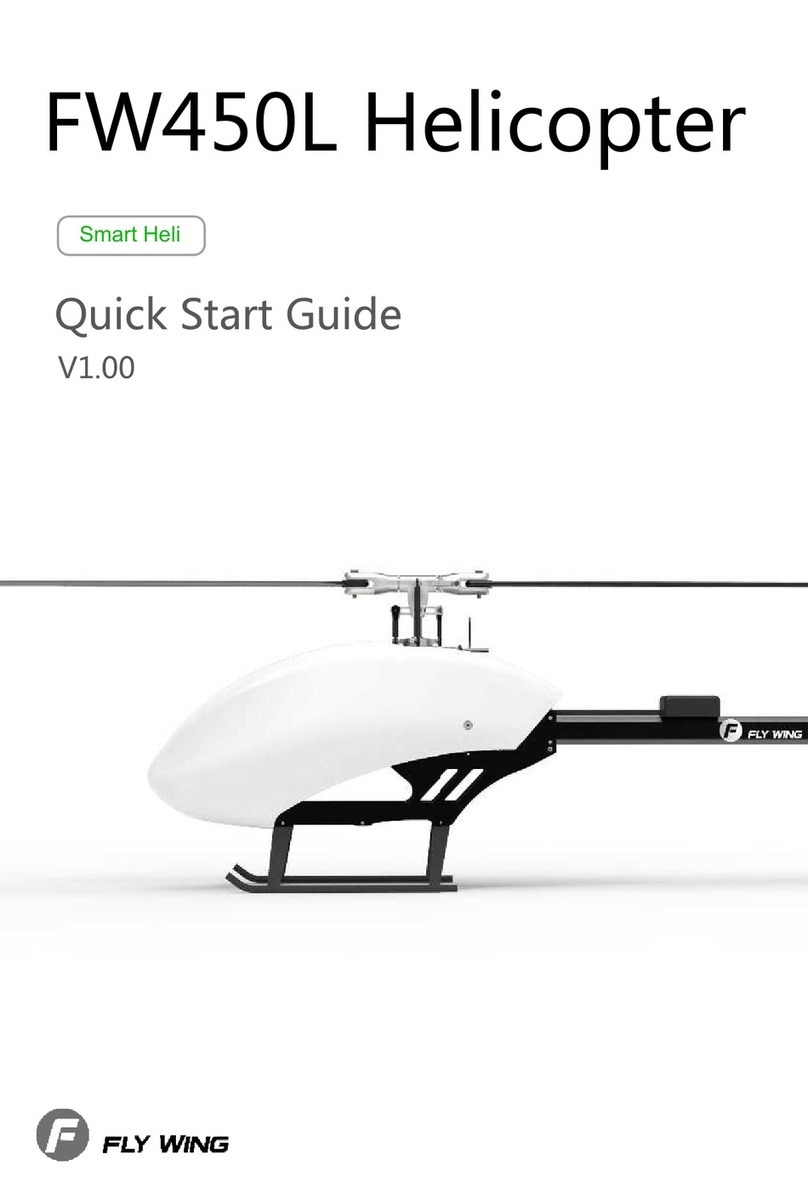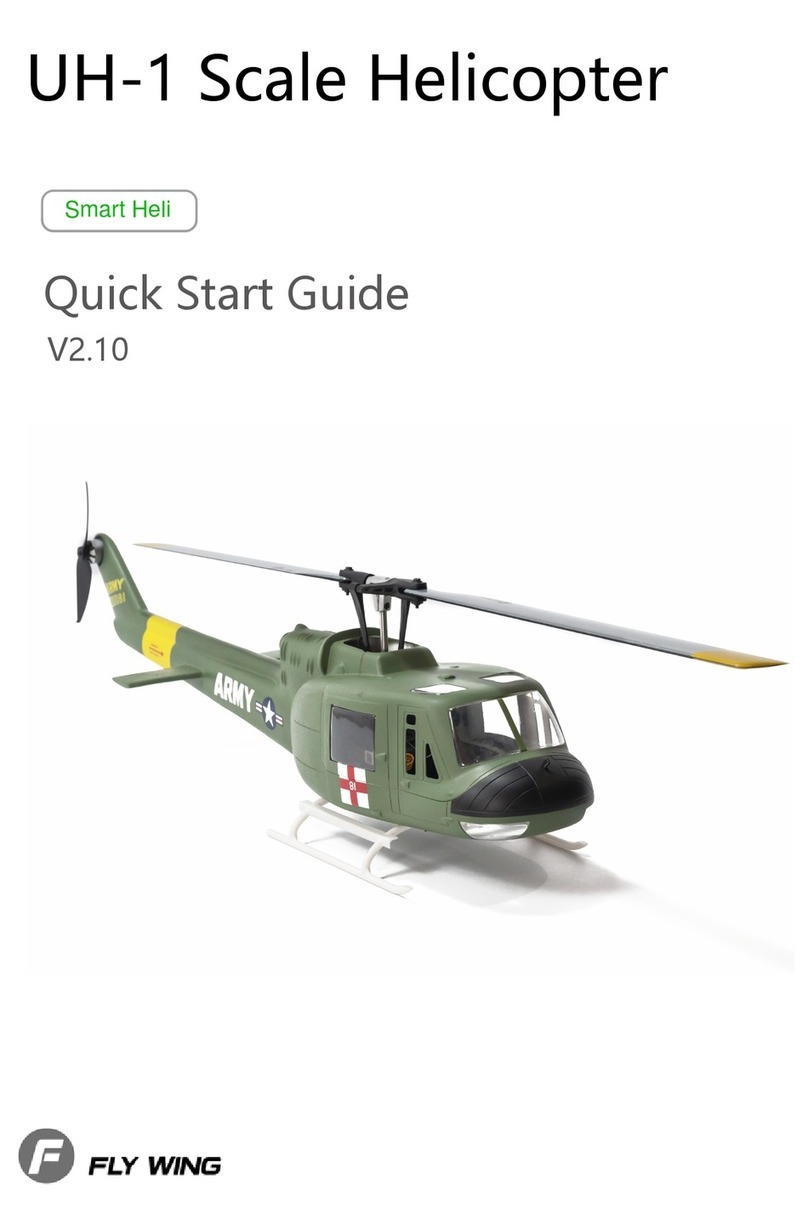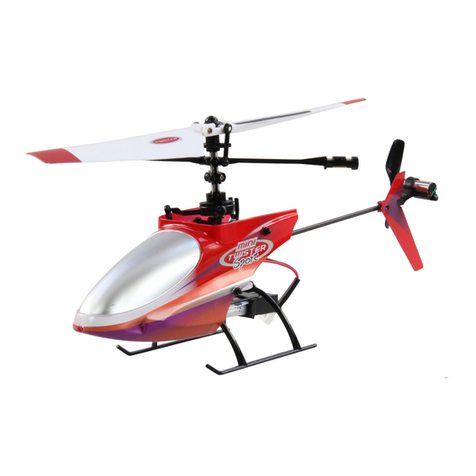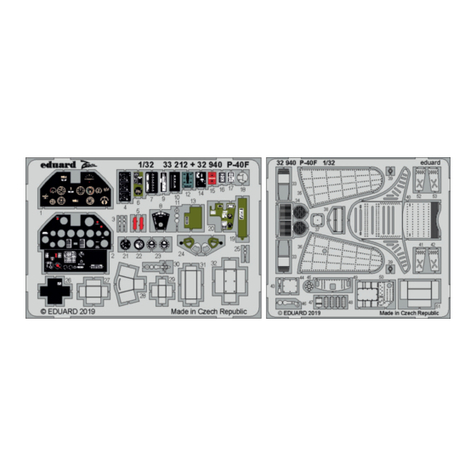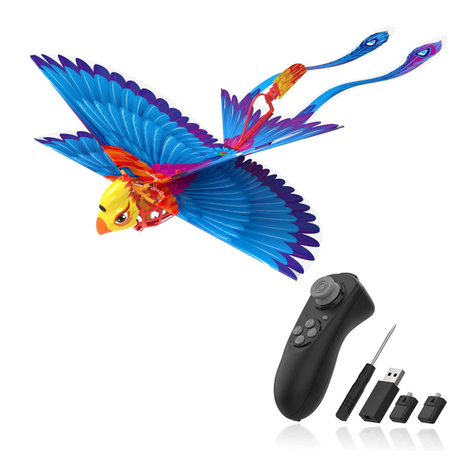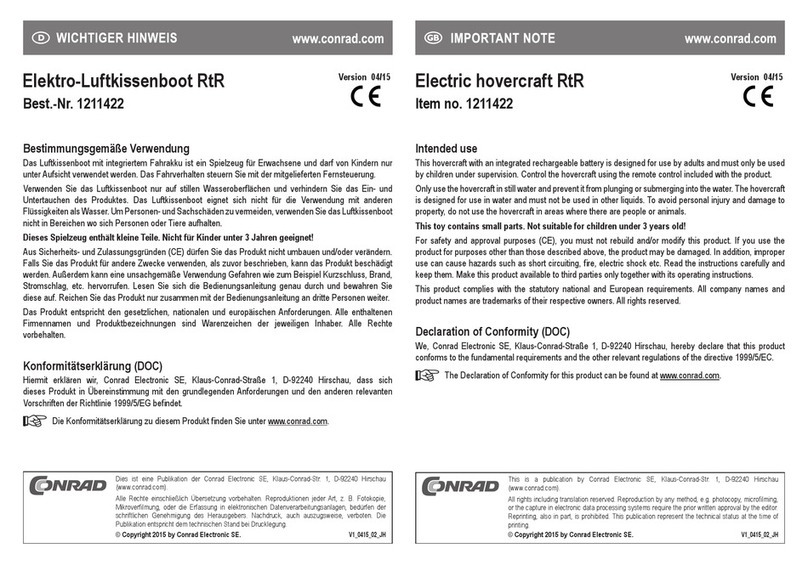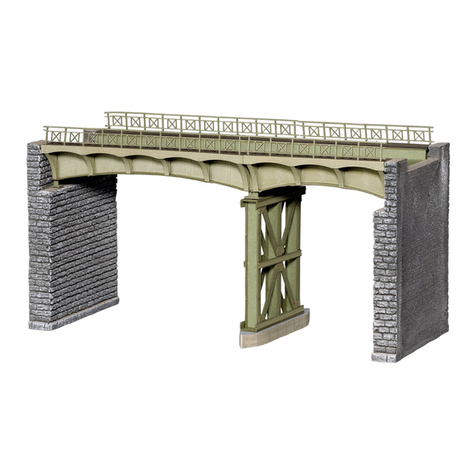Fly Wing Bell 206 User manual

●飞行环境要求
1恶劣天气下请勿飞行,如大风(10米/秒)、下雪、下雨、有雾天气等。
2. 选择开阔、周围无高大建筑物的场所作为飞行场地。大量使用钢筋的建筑物会影响指南针工作,而且会遮挡GPS
信号,导致飞行器定位效果变差甚至无法定位。
3请勿在有高压线、通信基站、发射塔或Wi- Fi热点等区域飞行,以免遥控器受到干扰。
4在海拔6000米以上飞行,由于环境因素导致飞行器电池及动力系统性能下降,飞行性能将会受到影响,请谨慎飞行。
5在南北极圈内飞行器无法使用 P 模式飞行,可以使用ATTI模式与视觉定位系统飞行。
技术规格
●自动返航过程中,飞行器不能自主躲避障碍,但用户可在遥控器信号正常时控制其飞行。在高大建筑物周围飞行时,要确保飞行
高度比建筑物高,或者在飞行前已经根据建筑物高度设置合适的返航高度(详见用户手册);否则切记不要飞到建筑物后面(建
筑物遮挡会导致遥控器信号中断而引发失控返航),以防失控返航过程中撞到建筑物。
自动返航
●定位模式(P模式)
飞行器利用GPS信号和视觉定位系统,精准定位、稳定悬
停,并且具备返航功能。
室外无遮挡的开阔地带才会有GPS信号。定位模式分为三种
状态:P-GPS: GPS信号良好,飞行器优先利用GPS信号
定位;P-OPTI: 无GPS信号、飞行器自动利用视觉定位系
统定位;P-ATTI: 无GPS信号且不满足视觉定位条件,飞
行器处于姿态模式。
视觉定位系统使用环境:高度在0.3~3米、光线充足地面
有清晰纹理的室内或室外环境。视觉定位系统不能在水面、
无清晰纹理的地面以及光线不足的环境精准定位。
视觉定位高度
30 cm-300 cm
GPS定位
●返航功能
GPS信号良好时,飞行器可以记录返航点以及自
动返航。DJI GO App 上GPS信号显示两格及以上
时,飞行器将记录此刻GPS坐标为返航点;飞行
器自动飞回返航点的过程称为返航。
智能返航:用户可通过遥控器的智能返航按键或
DJI GO App 的返航键,使飞行器自动返航。
智能低电量返航:当智能电量系统分析出当前电量
仅足够返航时,飞行器将自动返航。
失控返航:遥控器信号丢失的情况下,飞行器将自
动返航。
●飞行器
起飞重量 1280 g
最大上升速度 5 m/s
最大下降速度 3 m/s
最大水平飞行速度 16 m/s (姿态模式下)
最大飞行海拔高度 6000 m
飞行时间 约23分钟
工作环境温度 0℃至40℃
GPS模块 GPS/GLONASS双模
●云台
可控转动范围 俯仰:90至
+
30
●视觉定位系统
速度测量范围 < 8 米/秒 (高度 2 米,光照充足)
高度测量范围 30cm-300cm
精确悬停范围 30cm-300cm
使用环境 地面有丰富纹理,光照条件充足 (>15 lux,室内日光灯正常照射环境)
●相机
影像传感器 1/2.3 英寸 CMOS;有效像素1240万(总像素1276万)
镜头 FOV 94°20mm(35mm 格式等效) f/2.8
ISO范围 100 -3200(视频);100 -1600(照片)
电子快门速度 8秒 -1/8000秒
照片最大分辨率 4000×3000
照片拍摄模式 单张拍摄
多张连拍(BURST):3/5/7张
自动包围曝光(AEB):3/5张 @0.7EV步长
定时拍摄
录像分辨率 UHD: 2.7K (2704×1520) 24/25/30p
FHD: 1920×1080 24/25/30/48/50/60p
HD: 1280×720 24/25/30/48/50/60p
视频存储最大码流 40 Mbps
支持文件系统 FAT32(≤ 32 GB);exFAT(> 32 GB)
图片格式 JPEG,DNG(RAW)
视频格式 MP4/MOV(MPEG-4 AVC/H.264)
支持存储卡类型 Micro SD卡,最大支持64GB容量、传输速度为Class 10及以上或达到UHS-1评级的Micro SD卡
工作环境温度 0℃至40℃
●遥控器
工作频率 2.400 GHz -2.483 GHz
信号有效距离 FCC: 5000 米;CE: 3500 米
(无阻挡,无干扰)
视频输出接口 USB
工作环境温度 0℃至40℃
电池 6000 mAh 锂充电电池 2S
移动设备支架 支持平板与手机
等效全向辐射功率(EIRP) FCC: 20 dbm; CE:16 dbm
工作电流/电压 1.2 A @7.4 V
●充电器
电压 17.4 V
额定功率 57 W
●智能飞行电池(PH3-4480 mAh-15.2 V )
容量 4480 mAh
电压 15.2 V
电池类型 LiPo 4S
能量 68 Wh
电池整体重量 365 g
工作环境温度 -10℃至40℃
最大充电功率 100 W FCC IDSS3-WM3221503 FCC IDSS3-GL3001501
This device complies with part 15 of the FCC Rules.
Operation is subject to the following two conditions:
(1) This device may not cause harmful interference, and
(2) this device must accept any interference received, including
interference that may cause undesired operation.
飞行安全须知
DJI 强烈建议用户在安全、合理的环境中享受飞行乐趣。必要的飞行安全认识对于您、周围人群与环境的安全非常重要。
1. 在开阔的场地飞行:飞行时请远离建筑物、树木、高压线以及其它障碍物,同时远离水面、人群和动物。
2. 飞行过程全程操控:即使在使用自动起飞/降落和自动返航功能时,也请保持遥控器在手中,以随时控制飞行器。
3. 在视距范围内飞行:请保持飞行器始终在视距范围内,避免飞到高大建筑物以及其它可能阻挡视线的物体后面。
4. 控制飞行高度:为保证飞行器以及民航的飞行安全,请将飞行器的高度控制在120米以内。如您所在区域有禁飞
或低于120米的飞行高度限制规定,请遵照其规定。
将遥控器飞行模式切换开关切换至P档位
置,选用定位模式并等待GPS定位成功。
请访问 http://www.dji.com/cn/flysafe/no-fly 观看飞行安
全 教学视频以及获取飞行限制等更全面的安全知识。
●指南针校准
请依据 DJI GO App 或飞行器状态指示灯的提示进行指南针校准。校准注意事项如下:
1. 请勿在强磁场区域或大块金属附近校准,如磁矿、停车场、带有地下钢筋的建筑区域等。
2. 校准时请勿随身携带铁磁物质,如手机等。
3. 指南针校准成功后,将飞行器放回地面时,如果受到磁场干扰,DJI GO App 会显示处理方法,请按显示的方法
进行相应操作。
uic Start Guide
V1.
Bell-206 Scale Helicopter
Smart Heli
1
8
2 mm
172 mm
105 mm
71 mm
289.5 mm
289 mm
185 mm
uic Start Guide
V1.

About transmitter
Bell-206 using FS-i6S transmitter which is 2.4GHz, 1km* control distance.
it has been factory set, if the setting is
changed incorrectly, you will not be able
to start the helicopter.
Please don't touch your transmitter menu
快速入门指南
V1.2
PHANTOM 3
ADVANCED
*For the first time, you need to connect a computer to activate this function
*The maximum communication distance is measured in the experimental environment for reference only.
NO Function

©2015 大疆创新 版权所有
Designed by DJI. Printed in China.
ssemble BELL 206
1.Insert
Insert the wire into the flight control interface correctly, confirm that the selflocking bayonet
is in place, and confirm that the unit is fixed on the tail pipe.
固件升级以及了解产品全部信息,请访问官网产品专页下载
《Phantom 3 Advanced 用户手册》
http://www.dji.com/cn/product/phantom-3-adv
●遥控器信号正常时,智能返航过程中可使用遥控器
控制飞行航向。
智能返航:
长按遥控器的智能返航按键可使飞行器自动返航。
再短按一次该按键即可终止返航。
● 返航功能
智能低电量返航:
当智能电量系统分析出当前电量仅足够返航和降落时,
飞行器将自动返航。
失控返航:
当遥控器信号丢失时,飞行器将自动返航。
App一键返航按键智能返航按键
※本指南内容如有更新,恕不另行通知。
附 录
拍 摄飞行器状态指示灯
. . . 绿灯慢闪,GPS定位开启(P-GPS)
. . . 黄灯慢闪,姿态模式(P-ATTI/ATTI)
黄灯快闪,无遥控器连接
. . . 红灯慢闪,低电量报警
红灯快闪,严重低电量报警
—— 红灯常亮,严重错误 红黄灯交替快闪,
需校准指南针
. . . 绿灯双闪,视觉定位开启(P-OPTI)
未连接到飞行器
工作正常
B-B-B... 低电量或异常报警
B—B—... 闲置5分钟及以上
遥控器状态指示灯
●
通过遥控器的相机设置转盘可远程设置相机
拍摄参数;通过拍照、录影和回放按键控制
相机进行拍照、录影和回放;云台俯仰控制
拨轮可调整相机拍摄的俯仰角度。
●
使用 DJI GO App 可设置相机参数、控制
相机拍照、录影及回放。
●
通过 DJI GO App 相册将相机Micro SD
卡的拍摄素材同步到移动设备中,也可以
通过使用SD读卡器将拍摄素材导入电脑。
X2
2. Install blae
Install the blade as shown in the figure until there is slight resistance when the blade folds.
●在飞行过程中,切勿停止电机,否则飞行器将会坠毁。除非发生特殊情况(如飞行器可能撞向人群),需要紧急停止电机以最
大程度减少伤害。
●严重低电量报警时飞行器将无法起飞。
●电池低温报警:如果电池温度过低,DJI GO App 将提示未达到起飞条件,需先将电池预热后才能起飞。
●启动飞行器电机后螺旋桨将高速旋转,具有危险性。操作者应与飞行器保持一定距离,同时应使飞行器远离人群与建筑物、树
木或其它遮挡物,以免发生撞击。
●降落后请先关闭飞行器,再关闭遥控器。
● 手动起飞/降落
油门杆 / 向下 (缓慢)
降落:
缓慢向下拉动油门杆,飞行器降低飞行高度直至降落
至地面。将油门杆拉至最低位置以停止电机。
起飞:
同时向内(或向外)拨动左右摇杆,电机启动后松
开摇杆。缓慢向上推动油门杆(默认左摇杆),飞行
器起飞。
油门杆 / 向上 (缓慢)启动 / 停止电机
或
3.Maintenance-Replace the tail blade
If the tail rotor is damaged or has obvious crack,please replace it in time. When replacing,the side with
words on the tail face the motor. Pay attention to the installation direction.

©2015 大疆创新 版权所有
Designed by DJI. Printed in China.
perate Bell 206
固件升级以及了解产品全部信息,请访问官网产品专页下载
《Phantom 3 Advanced 用户手册》
http://www.dji.com/cn/product/phantom-3-adv
●遥控器信号正常时,智能返航过程中可使用遥控器
控制飞行航向。
智能返航:
长按遥控器的智能返航按键可使飞行器自动返航。
再短按一次该按键即可终止返航。
● 返航功能
智能低电量返航:
当智能电量系统分析出当前电量仅足够返航和降落时,
飞行器将自动返航。
失控返航:
当遥控器信号丢失时,飞行器将自动返航。
App一键返航按键智能返航按键
※本指南内容如有更新,恕不另行通知。
附 录
拍 摄飞行器状态指示灯
. . . 绿灯慢闪,GPS定位开启(P-GPS)
. . . 黄灯慢闪,姿态模式(P-ATTI/ATTI)
黄灯快闪,无遥控器连接
. . . 红灯慢闪,低电量报警
红灯快闪,严重低电量报警
—— 红灯常亮,严重错误 红黄灯交替快闪,
需校准指南针
. . . 绿灯双闪,视觉定位开启(P-OPTI)
未连接到飞行器
工作正常
B-B-B... 低电量或异常报警
B—B—... 闲置5分钟及以上
遥控器状态指示灯
●
通过遥控器的相机设置转盘可远程设置相机
拍摄参数;通过拍照、录影和回放按键控制
相机进行拍照、录影和回放;云台俯仰控制
拨轮可调整相机拍摄的俯仰角度。
●
使用 DJI GO App 可设置相机参数、控制
相机拍照、录影及回放。
●
通过 DJI GO App 相册将相机Micro SD
卡的拍摄素材同步到移动设备中,也可以
通过使用SD读卡器将拍摄素材导入电脑。
X2
. harging
●lease use the official charger we provide you to charge. Take out the
flight battery before charging.
●
onnect the charger to an power source 1 , H use a power adapter if necessary.
●ake sure the battery temperature is normal and connect the battery white jstx balance lead to the
charger. yellow main power plug is not inserted
●When the charger is connected, the charger screen will display the voltage and when full, the symbol
F will be displayed.
●o not plug in ss at the same time. nly one battery can be charged at a time. If the charger
shows the symbol of e.11 , the battery feed is damaged a single cell is less than ..
●在飞行过程中,切勿停止电机,否则飞行器将会坠毁。除非发生特殊情况(如飞行器可能撞向人群),需要紧急停止电机以最
大程度减少伤害。
●严重低电量报警时飞行器将无法起飞。
●电池低温报警:如果电池温度过低,DJI GO App 将提示未达到起飞条件,需先将电池预热后才能起飞。
●启动飞行器电机后螺旋桨将高速旋转,具有危险性。操作者应与飞行器保持一定距离,同时应使飞行器远离人群与建筑物、树
木或其它遮挡物,以免发生撞击。
●降落后请先关闭飞行器,再关闭遥控器。
● 手动起飞/降落
油门杆 / 向下 (缓慢)
降落:
缓慢向下拉动油门杆,飞行器降低飞行高度直至降落
至地面。将油门杆拉至最低位置以停止电机。
起飞:
同时向内(或向外)拨动左右摇杆,电机启动后松
开摇杆。缓慢向上推动油门杆(默认左摇杆),飞行
器起飞。
油门杆 / 向上 (缓慢)启动 / 停止电机
或
The yellow plug of the battery is connected to
the side plug of the helicopter
TX-tritter poer
RX-eceier coectio
propt
, elicopter poer-
etti(o toch)
. Helicopter ower
lease insert the battery into the abdomen of the helicopter . e sure that the battery strap is securely
fastened. onnect the yellow plug of the battery to the Helicopter. eep the helicopter stationary. fter
the initializing movement of the swash plate and the rotor head is completed, install the canopy
correctly.
1. tar transmitter
Hold the two power buttons at the same time for two seconds to turn on the transmitter. If the
transmitter shows any warning please flip the motor run switch to top positionmotor off
actionthen turn the mode switch to position.

使用您的PHANTOM 3 Advanced
3. 检查电量
请分别短按一次遥控器和智能飞行电池的电源开关以检查电量。首次使用智能飞行电池,请务必充满电。
短按一次、再长按2秒遥控器电源开关可开启遥控器(重复本操作可关闭遥控器)。
短按一次、再长按2秒智能飞行电池开关可开启智能飞行电池(重复本操作可关闭智能飞行电池)。
●推荐在平板设备上使用DJI GO App以获得最佳的体验。DJI GO App要求使用iOS 8.0及以上系统和Android 4.1.2及以上系统。
1. 下载 DJI GO App
安装 DJI GO App,请在软件商店或扫描下方二维码下载。
或用移动设备访问以下网址:http://m.dji.net/djigo
2. 观看入门教学视频
扫描二维码观看扫描二维码下载安装
低 高
电量
使用Phantom 3Advanced 之前,请 在DJI GO App 或者 DJI 官方网站产品页面完整观看教学视频与下载阅读
《Phantom 3 Advanced 用户手册》,并仔细阅读以下包装内文档:《Phantom 3 Advanced 快速入门指南》、
《Phantom 3 免责声明和安全操作指引》、《Phantom 3 智能飞行电池安全使用指引》和《物品清单》。
4.充电
●请使用 DJI 官方提供的充电器充电。充电前需将智能飞行电池取出。
●连接充电器到交流电源(100~240 V,50/60 Hz;如需要请使用电源转换插头)。
●智能飞行电池、遥控器开启或关闭的状态下均可充电。建议在关闭状态下充电。
●在关闭状态下充电时,智能飞行电池与遥控器指示灯全部熄灭表示电已充满。
B
A
BA
取出智能飞行电池
低 高
电量
请在 DJI GO App 或访问DJI官方网站观看。
http://www.dji.com/cn/product/phantom-3/video
www.dji.com
ADVANCED
PHANTOM 3
•o not stop the motor during flight, otherwise the helicopter will crash. nless there are special circumstances
e.g. the helicopter may collide with a crowd, it is necessary to stop the motor urgently to minimie the injury.
•The helicopter will not be able to take off in case of serious low power alarm.
•fter starting the helicopter motor, the blade will rotate at high speed, which is dangerous. The operator shall
keep a certain distance from the helicopter and keep the helicopter away from the crowd, buildings, trees or
other obstructions to avoid collision.
fter landing, please turn off the helicopter power first and then the transmitter.
● mode unlock take off take mode as an example
. eady to fly
lease place the helicopter in a flat open outdoor area with user facing the tail.
1Turn the transmitter motor run
switch to stop position, dial
mode switch to , and the H1
light is flashing yellow.
ove the helicopter to the outdoor open
environment without trees and buildings,
and power on to wait for the satellite
signal search.
fter waiting for a few minutes, the
light changes from flashing yellow to solid
green . The helicopter was positioned
successfully.
nlock as shown in the figure and hold
for about seconds until the H1
flight control unit flashes green light.
While the green light is flashing, turn
the stop switch to run position , and the
helicopter motor will start the light is
solid green, repeat the unlock procedure
again.
When the helicopter rotor head
speed is stable, push the throttle stick
upwards to take off and raise the
helicopter above ground , then release
the throttle stick and you can hover
appropriately.

使用您的PHANTOM 3 Advanced
3. 检查电量
请分别短按一次遥控器和智能飞行电池的电源开关以检查电量。首次使用智能飞行电池,请务必充满电。
短按一次、再长按2秒遥控器电源开关可开启遥控器(重复本操作可关闭遥控器)。
短按一次、再长按2秒智能飞行电池开关可开启智能飞行电池(重复本操作可关闭智能飞行电池)。
●推荐在平板设备上使用DJI GO App以获得最佳的体验。DJI GO App要求使用iOS 8.0及以上系统和Android 4.1.2及以上系统。
1. 下载 DJI GO App
安装 DJI GO App,请在软件商店或扫描下方二维码下载。
或用移动设备访问以下网址:http://m.dji.net/djigo
2. 观看入门教学视频
扫描二维码观看扫描二维码下载安装
低 高
电量
使用Phantom 3Advanced 之前,请 在DJI GO App 或者 DJI 官方网站产品页面完整观看教学视频与下载阅读
《Phantom 3 Advanced 用户手册》,并仔细阅读以下包装内文档:《Phantom 3 Advanced 快速入门指南》、
《Phantom 3 免责声明和安全操作指引》、《Phantom 3 智能飞行电池安全使用指引》和《物品清单》。
4.充电
●请使用 DJI 官方提供的充电器充电。充电前需将智能飞行电池取出。
●连接充电器到交流电源(100~240 V,50/60 Hz;如需要请使用电源转换插头)。
●智能飞行电池、遥控器开启或关闭的状态下均可充电。建议在关闭状态下充电。
●在关闭状态下充电时,智能飞行电池与遥控器指示灯全部熄灭表示电已充满。
B
A
BA
取出智能飞行电池
低 高
电量
请在 DJI GO App 或访问DJI官方网站观看。
http://www.dji.com/cn/product/phantom-3/video
www.dji.com
ADVANCED
PHANTOM 3
bout the use of fully manual mode.
When the helicopter is flying in the air, switch from mode switch to mode, the helicopter will
fall down uickly. If you are a novice, it is very dangerous to operate this function, and the helicopter
will crash. xperienced pilots can uickly and manually increase pitch control after switching to
mode.
●nlock take off in mode take mode as an example
1ial the motor run switch to stop position, dial the
mode switch to position,
ove the helicopter to the outdoor open
environment without trees and buildings.
ower on, and the H1 flight control light is solid
blue.
nlock as shown in the figure and hold
for about seconds until the flight control
light is flashing blue.
uring the blue light is flashing, ial motor
switch stick to run position,and the helicopter
motor will run. ush throttle stick upwards to take
off.
. Home ode
If you need to use the home mode one key to return, low power return, please make sure that the
satellite signal is good before takeoff, and there are no buildings or trees around the takeoff point that
hinder the return.
●mart return
ial the switch to H,the helicopter return automatically. Then dial to mode to terminate the
return flight.
•ow power return when the power system judges that the current power is low, it will auto return
and land. lease ensure that the current distance of the helicopter conforms to the range of the
helicopters remaining power.
•When returning with low power, the helicopter will auto rise up to 1 meters, and then return,
which isnt controlled by the operator. If there are obstacles trees or buildings on the way back,
the auto flight needs to be terminated
●Ways to stop low power
•If you want to stop the low power return, please flick the switch to H, and then flick the switch
to . You can manually control the helicopter after landing and manually turn off the motor.
uring this period, the helicopter will not return with low power until the helicopter is powered off.

使用您的PHANTOM 3 Advanced
3. 检查电量
请分别短按一次遥控器和智能飞行电池的电源开关以检查电量。首次使用智能飞行电池,请务必充满电。
短按一次、再长按2秒遥控器电源开关可开启遥控器(重复本操作可关闭遥控器)。
短按一次、再长按2秒智能飞行电池开关可开启智能飞行电池(重复本操作可关闭智能飞行电池)。
●推荐在平板设备上使用DJI GO App以获得最佳的体验。DJI GO App要求使用iOS 8.0及以上系统和Android 4.1.2及以上系统。
1. 下载 DJI GO App
安装 DJI GO App,请在软件商店或扫描下方二维码下载。
或用移动设备访问以下网址:http://m.dji.net/djigo
2. 观看入门教学视频
扫描二维码观看扫描二维码下载安装
低 高
电量
使用Phantom 3Advanced 之前,请 在DJI GO App 或者 DJI 官方网站产品页面完整观看教学视频与下载阅读
《Phantom 3 Advanced 用户手册》,并仔细阅读以下包装内文档:《Phantom 3 Advanced 快速入门指南》、
《Phantom 3 免责声明和安全操作指引》、《Phantom 3 智能飞行电池安全使用指引》和《物品清单》。
4.充电
●请使用 DJI 官方提供的充电器充电。充电前需将智能飞行电池取出。
●连接充电器到交流电源(100~240 V,50/60 Hz;如需要请使用电源转换插头)。
●智能飞行电池、遥控器开启或关闭的状态下均可充电。建议在关闭状态下充电。
●在关闭状态下充电时,智能飞行电池与遥控器指示灯全部熄灭表示电已充满。
B
A
BA
取出智能飞行电池
低 高
电量
请在 DJI GO App 或访问DJI官方网站观看。
http://www.dji.com/cn/product/phantom-3/video
www.dji.com
ADVANCED
PHANTOM 3
ppendix
Helicopter tatus Indicator escription
When the transmitter signal is normal, the transmitter can be used to control the landing
position during the return landing.
reen solid status is good, can take off
Yellow flash
ed flash slowly
helicopter is getting positioning
ompass calibration reuired
lue solid status is good, can take off
reen,yellow flash ow battery power in mode
lue, yellow flash ow battery power in mode
urple solid eturn mode or automatic flight mode
ed flash uickly eceiver has no signal
reen flash status has been locked, start switch can start motor
lue flash status has been locked, start switch can start motor
•sers can increase or decrease the return voltage according to the flight demand, or turn off the
low power return function.
t i recoee to et the retr olte
etee hich ill ect
the ctl liht rtio retr itce

alibration precautions
lease select an open space and calibrate the compass according to the steps below. For more
information on compass calibration, please visit httpswww.flywingrc.comvideo Watch relevant
teaching videos. ethods calibration was carried out with parameter adjustment software
1.pen httpswww.flywingrc.comsoftware ownload a software.
2. onnect flight control and computer with type data cable
3. elect the corresponding port generally not 1 and click onnect.
4.nter the sensor calibration option of parameter adjustment software, check the learning mode, and
click tart calibration.
5. The rotor rotates in upright position of the helicopter and in the inverted upside down
position.
6. Head up vertical rotation degrees, head down vertical rotation degrees.
7. If the progress bar does not end, repeat the above operation until the end of the calibration
progress bar indicates that the calibration is successful.
. ompass calibration
ompass is easy to be disturbed by strong electric field, strong magnetic field and strong
electromagnetic field, which will lead to abnormal compass and even cause flight accidents. egular
calibration can make the compass works at its best.
ittio reiri reclirtio
1. ompass data abnormal, helicopter status light
red flashing
. The flight site is far away from the last compass
calibration site
. The structure of helicopter is changed
. The drift is serious during flight, or it cant fly in a
straight line.
※hi ie i ect to pte ithot prior otice
1. o not calibrate in the area of strong magnetic field and electric field or near large metal, such as
magnetic ore, parking lot, building area with underground reinforcement, etc.
2. o not carry ferromagnetic materials, such as keys, watches, speakers, etc. when calibrating.
3. If the compass is calibrated indoors, remember to recalibrate when changing to outdoor flight to
prevent compass abnormality during flight due to magnetic field difference between the two places.
4. lease move the helicopter to another location when there may be steel materials affecting the
compass.
alibration procedure

hort press the wrench icon to enter the
menu
nter the YT menu and click sticks mode elect the corresponding mode on the right
side of the screen and press the arrow in the
upper left corner to return
Fco
11. Get more information
Welcome to join the Facebook H1 flight control technology exchange group. If you have any doubts, you
can find more teaching contents in this discussion group. Welcome to follow the official YouTube channel
for more teaching videos. Welcome to contact us on the official website
Facebook Youtobe
. Model 1/Model 2 change
How to change 1 to
1When the helicopter is powered off, press
and hold the screen lock icon for about
seconds to unlock the screen
10.
oes the servo arm move in mode
In mode, the servo arm does not move, and it will move only after unlocking. uring adjusting,
you can switch to mode to view the servo arm movement
fter the helicopter motor run is unlocked, the motor rotates autonomously, and the rotor rpm speed is
not controlled by the throttle stick
The transmitter controls the flight of the helicopter by adjusting the pitch
I pick up helicopter, do not install blades, unlock and start the helicopter, servo arm irregular movement
H1 recognizes that blades are not on. Servo will not move correctly.

●Flight environment requirements
Flight safety notice
Flywing suggests that users enjoy flying in a reasonable safe environment. The knowledge of flight safety is
very important for the safety of yourself, the surrounding people and the environment.
1.Fly in open areas away from buildings, trees, High voltage power cable lines, crowd, water surface, and any near by
obstacle.
2.Please keep the remote control transmitter in hand, even when using the Auto Flight / Auto Landing and Auto
Return Home function, to control the helicopter at any time.
3.Please fly the helicopter within your sight range at all times
4.To ensure flight safety, please do not fly the helicopter beyond 120 meters above the ground. If there are no
flying height restrictions or if the restriction is lower than 120 meters in your area, please follow the regulations
Please visit http://www.flywingrc.com Watch flight safety
teaching videos and acquire more comprehensive safety
knowledge such as flight restrictions
●PreFlight safety inspection
Please check the helicopter carefully before taking off. Precautions are as follows:
1.Check whether the main blades ,tail blades, helicopter body and landing skids are damaged or distorted,
please replace them with the genuine Fly Wing RC parts.
2.Check whether the flight control linkages and fuselage are fixed firmly, and whether the GPS unit is
correctly fixed on the helicopter tail boom (horizontally placed, straight line behind the main mast )
H1 Unit is fixed firmly on the double sided foam pad either at the front or at the back of the main
mast. Pay attention to the direction of the arrow which has to be pointed towards the direction of
travel
3.Check whether the power of the helicopter and the transmitter are sufficient. After the transmitter is
powered on, turn on the power supply of the helicopter, and check whether the helicopter passes the
self inspection test (the rotor head and swashplate move regularly for several seconds)
快速入门指南
V1.2
PHANTOM 3
ADVANCED
1. Do not fly in bad weather, such as strong wind (10m / s), rain, snow and foggy weather, etc.
2. Choose an open place with no tall buildings around the flight pathway. Any large number of buildings using
steel bars will affect the effectiveness of compass function , and they will block GPS signal, resulting in poor
positioning of helicopter and even unable to receive the signals.
3. Please do not fly in any area with high voltage cable line, radio tele-communication station, mobile phone
transmission tower or Wi-Fi, to avoid signal interference of your transmitter and receiver.
4. Please take extra caution when flying above 6000 meters as performance of the battery and the motor power
system of the helicopter will be reduced to cold temperature and thinner air density.
●Flight operation requirements
5. Fly within your sight of rangeVLOS
6. Keep away from rotating blades and motor.
7. Activating the stop switch during flight will cause the helicopter to fall. Please use this function only in
case of emergency.
8. During the flight, please do not answer or make phone calls, send short messages or use other mobile
devices that may interfere with your helicopter operation.
9. Do not operate the helicopter under the influence of alcohol or drugs.
10. Please return home as soon as possible when low power warning appears from the transmitter.
11. In the process of runaway return, when the radio signal becomes normal again, the helicopter landing
position can be controlled by the transmitter.
12. After landing, the helicopter electronic power should be stopped first and then the transmitter should be
turned off to avoid any loss of transmitter signal.
13. When using the GPS Autopilot flight mode and Return Home functions, you should always be prepared
to control the helicopter manually by turning the transmitter 3D mode switch in case of Emergency .
Please note that the helicopter is still in the Auto GPS flight mode state at this time. If you need to completely
exit the flight mode, please turn the flight stop button on the transmitter.
14. Please keep control of the helicopter all the way. Do not rely on GPS to provide information. In specific flight
mode or flight environment, GPS system can not work normally, such as precise landing or active braking

认识您的PHANTOM 3 Advanced
Phantom 3 Advanced 具备自动返航以及通过视觉定位系统实现室内稳定悬停、飞行的功能可以拍摄1080p/60fps
全高清视频和1200万像素的静态照片。
以下为 Phantom 3 Advanced 的机身构造:
快速入门指南
V1.2
PHANTOM 3
ADVANCED
1. 一体式相机云台
2. 视觉定位系统
3. 相机Micro SD卡槽
4. Micro USB接口
5. 相机状态指示灯
6. 机头LED指示灯
7. 电 机
8. 螺旋桨
9. 飞行器状态指示灯
10. 天 线
11. 智能飞行电池
12. 电池开关
13. 电池电量指示灯
14. 对频按键
15. 相机数据接口
2
7
4
5
8
6
1
3
9
12
11
15
10
14
13
isclaimer
The remote control model is not a toy. This product is o utabe to adults o ae eeece
coect model helicopter assembly, setting, commissioning and operation e ecote ou o be
o in legal remote control fl field. This product is not suitable for children or those who do not
hae eeece emote control model helicopters. Fo neperience o a e bee te ecote
must be oeate under the direct ueo of someone with considerable sill or epertise. The
remote control model product of this specification belongs to the operator who has high operational
sills Improper or unfamiliar use of th product may cause serious harm to yourself and others, or een
deat the product is disassembled it ca cause loss of parts in aou situations. If the product is
defectie ue to oe use, it will not be possible for u to replace with the new product or to accet
return of the ite ,under the warranty conditions. The dealer is unable to correct the abnormal loss of
parts and components, becaue o the end user improper installation and setting methods, modification
of the goods including use of the non-original parts, other euipment that does not meet the
specifications, and poor operation. For any damage, accident or inury caused,. Buyers and Operators
assume full responsibility at the time of purchase. Those who can not operate any professional remote-
controlled model helicopters, they shall not operate this product. At the same time, the operator must
operate in the legal remote control model fl site, pay attention to the personal safety of himself and
others and strictly abide by and comply with national and local laws and regulations. The whole machine
hood is a fragile product. Many glass fiber at are surface painting products. Due to shrinage,
temperature and transportation process, there may be problem o blasting and cracing o tee te
This is te atue of the product itself. e ca not be eobe o a eou obe ate
face-to-face courier signe direct deliery of the ouct to ou lease be aae o te a
coto before you buy this sophisticated high tech radio control helicopter
hroh rei of the etire er l to ilirize ith the proct ctio eore
he ocettio o thi proct i ect to pte ithot prior otice lee iit the oicil eite httplircco o to the proct pe or
the ltet iortio
opertio the proct i ot operte correctl it ce erio ir to orel or other or ce
proct e propert lo hi proct i cople it ee to e ilir ith it or perio o tie
eore e age you ee to he oe ic olee eore opertio there i o tro
et ree iproper opertio le to proct e propert lo ee ce erio
ir to oeel or other hi proct i ot itle or chilre o ot e prt ot
proie or recoee or cop You t trictl ollo the cop ielie to itll
e thees proct hi ice ocet coti et opertio itece itrctio e
re to re ll itrctio ri i the er l crell eore eli etti p
i o he re ertoo ll the cotet o thi ocet eore i it
ai ssible inur an lss it is irtant t bsere te llin ites
1. sers are not allowed to operate this product in any condition of poor physical or mental state
such as drinking, drug taking, drug anesthesia, diiness and fatigue, nausea, etc.
2. xcept in special circumstances such as the helicopter may hit a crowd, it is forbidden to turn
off the engine during the flight
3. fter landing, be sure to turn off the helicopter before turning off the remote control
transmitter.
4. It is forbidden to use this product to throw or launch any dangerous object to buildings,
people or animals.
5. The user shall immediately stop using the helicopter with abnormal flight status in case of
accident such as collision or overturning. The user shall not continue to use the helicopter
until it is repaired by the company or its recommended maintenance center.
ri
and other functions will not be available. lease make a reasonable judgment on the flight condition by
naked eye observation, and set the corresponding flight and return altitude according to the flight
environment.
Table of contents
Other Fly Wing Toy manuals
Popular Toy manuals by other brands
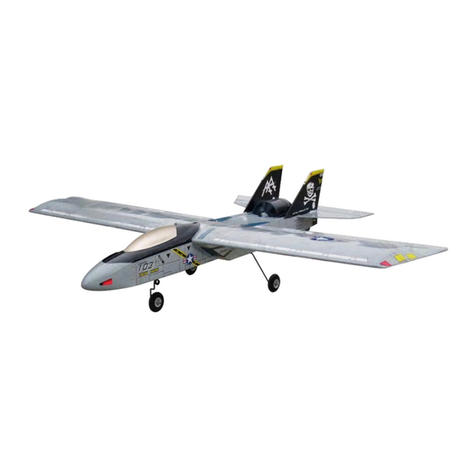
THE WORLD MODELS
THE WORLD MODELS Jeff Troy's TAMEcat DF Trainer instruction manual

Meister
Meister F4-U Corsair Assembly instructions
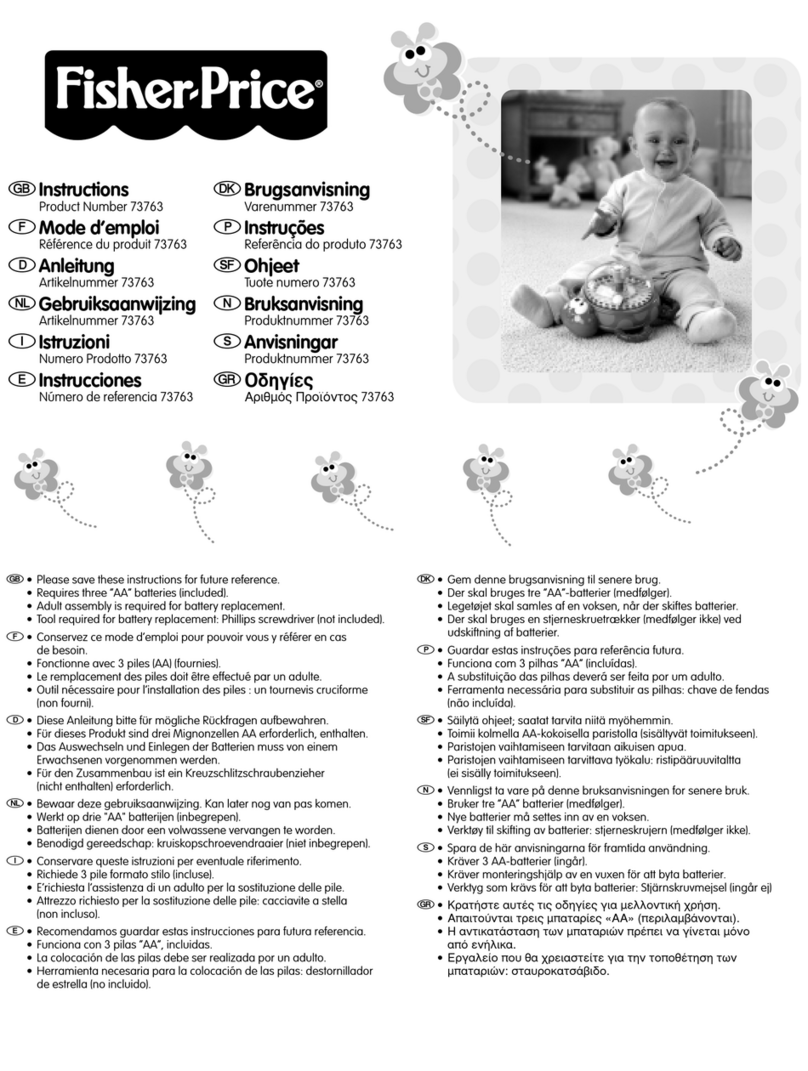
Fisher-Price
Fisher-Price 73763 instructions

Hasbro Gaming
Hasbro Gaming ELEFUN & FRIENDS B7714 manual
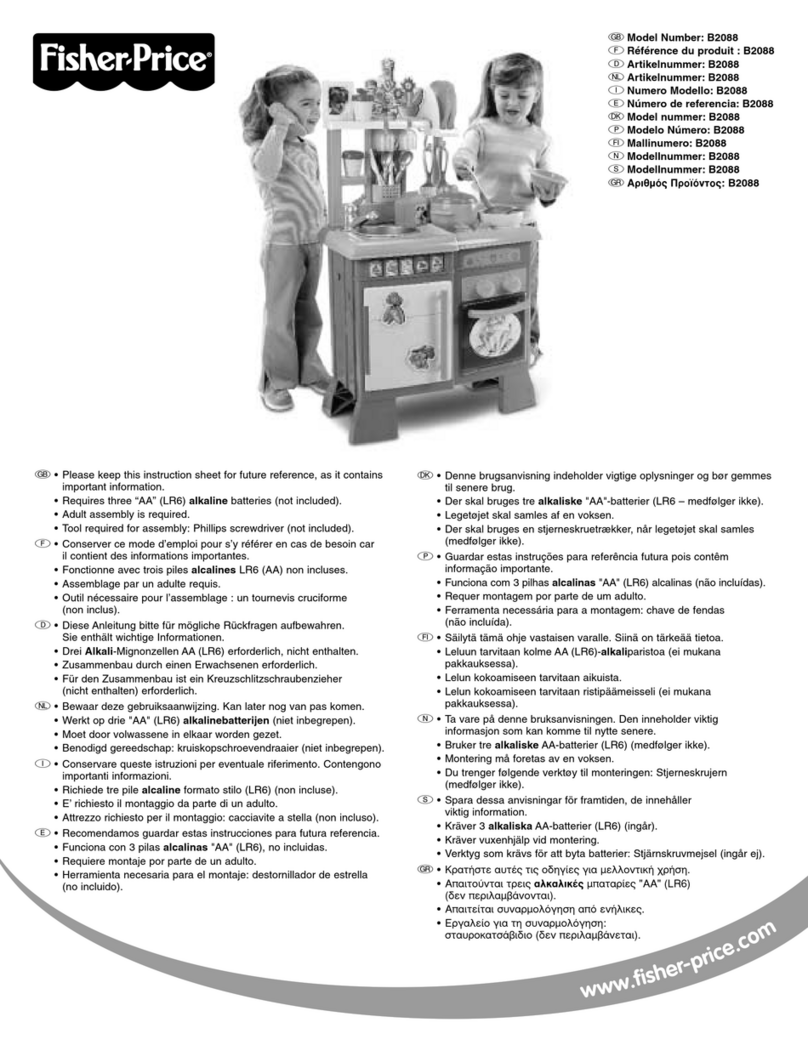
Fisher-Price
Fisher-Price B2088 instruction sheet
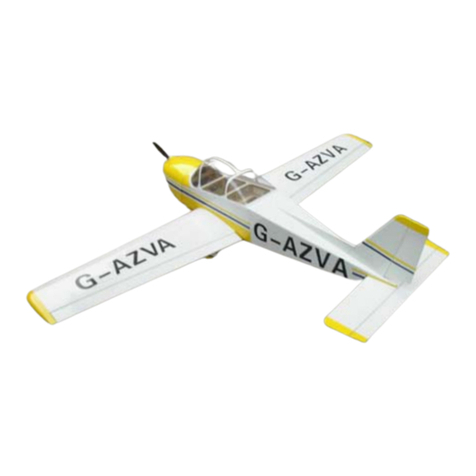
Flight Model
Flight Model Monsun-60 Assemble manual
